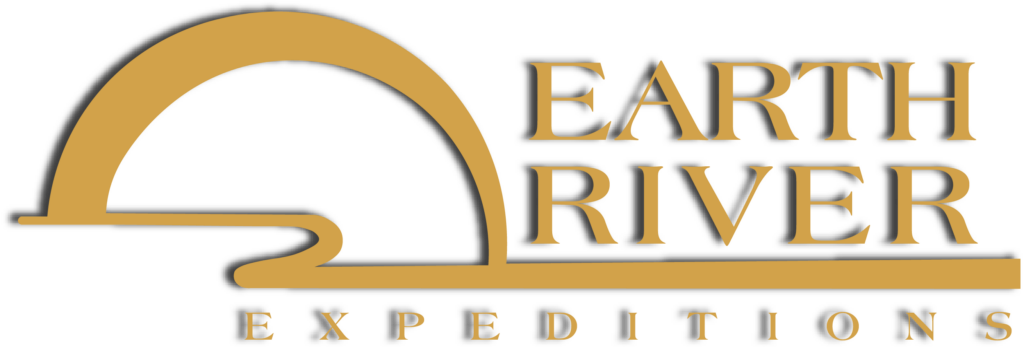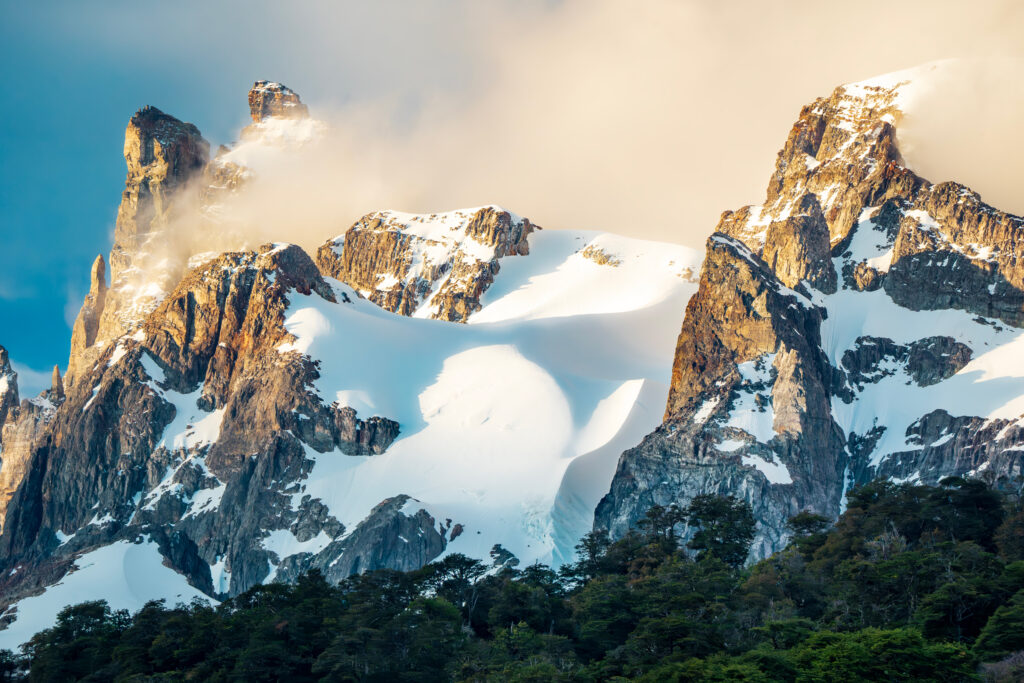Earth River’s discovery and exploration of a future Patagonia Classic
In 2015, we completed a first descent of a remote river in Patagonia with the unremarkable name Quinto (Fifth), which I had first scouted on topographical maps twenty years earlier. There were four other small rivers in the area, all within the same drainage system, with non-descriptive names ranging from Uno to Quattro (One to Four).
Judging from the maps, reaching the headwaters required a seven-mile trek along the Sendero de Chile’s Heritage Trail, a route once used for cattle driving. A team of pack horses, if you could find them, would be necessary to reach the river. At the confluence with the trail, the river looked small, and it didn’t seem worth rounding up the horses and mounting an expedition only to arrive and find there wasn’t enough water. I forgot about the river for over two decades.
In 2014, I stumbled upon the same river on Google Earth. The valley was remote, lacking roads and bridges, with only a few tiny homesteads cloaked in dense forest. As I scrolled through various images taken during different months, I was surprised to see that the river always seemed to have an adequate flow for rafting. There appeared to be dozens of runnable rapids. The mountains rising from the river were covered in snow and ice, and were even higher and more impressive than those in the neighboring Futaleufú Valley.

From Google Earth to Gauchos
A few weeks later, I walked into a one-room wooden building in Lago Verde, a windswept village on the Patagonian steppe. Tourism was nonexistent, and the place reminded me of Futaleufú when I first visited in the late 1980s. Behind a desk, the town’s sole policeman told me about his cousins who lived along the Río Quinto, owned horses, and happened to be in town for a few days picking up supplies.
The first time I met the cousins, they were on horseback. Clad in loose-fitting trousers tucked into tall leather boots, lamb’s wool chaps, and woolen ponchos, they wore wide-brimmed hats and had machetes secured to their belts. Up on their horses, they looked like something out of a time warp.
“Hablo un poco de Español,” I said, hoping to lower their expectations about my limited command of Spanish. I introduced myself. They replied in serious tones, “”Gustavo,” “Rolando,” clearly not used to dealing with gringos and wondering what I wanted.
I described my plan to run the river the following year. They were wary but intrigued. They had never met anyone in a puffy down jacket, spoke like a struggling first grader, and was foolish enough to take a boat down their river.
“Muchos rápidos feos en el río,” Gustavo said, referring to the many “ugly” rapids.
They dismounted, and I showed them a page with a Google Earth screenshot of a spot on the river that clearly looked like it would require a portage. Pointing to the cataract on the page, Rolando’s said it was at their friend Waldo’s farm and impossible in a boat.
“De avión?” Gustavo asked, wondering if the images were taken from an airplane.
“Satellite.”
“Increíble,” they said in unison, clearly amazed. Gustavo asked if he could take a look at my stack of Google Earth printouts, which he began rifling through. “Mi campo,” he said proudly, landing on a page and pointing to a speck of a house and a cleared area carved into the wilderness on the upper reaches of the river. “No ventana,” he said, passing the paper to Rolando for a look.
“Si, sin la ventana,” Rolando confirmed after scanning the image and handing the papers back to me.
They couldn’t see the window, whatever that meant. I regretted not taking Spanish more seriously in high school, as I was clearly missing something.
I invited them to join us on the river. They stared at me like I was crazy. Their reaction reminded me of my early years on the Futaleufú. To locals, rivers were places to drown in, not to recreate on. In the early days on the Futaleufú, after some cajoling, Mario Toro, the patriarch of the valley, had traded his machete for a paddle and came with me down the river. Sitting in the raft in a wetsuit and helmet, he was unrecognizable. He was terrified in the first rapid, but by the end, he seemed to enjoy it, although he never asked to come back.
Changing the subject, I asked them about renting horses the following January. Without horses, there wasn’t going to be an expedition.
“Poco loco,” Gustavo shrugged, realizing I was not about to be talked out of my crazy scheme.
“En un bote, muy loco.” Rolando added.
Getting down to business, Gustavo asked how many horses I needed, and I listed our gear for him. After some consultation they came up with a minimum of eleven horses. They only owned four, so the others would have to be rounded up and rented from neighbors. They mentioned there was a trail along the river I hadn’t known about and asked how long I’d need the horses.
The idea of transporting the gear down the river by pack horse was novel and had never occurred to me. With horses, we could skip bringing baggage boats, which would simplify the portages. I asked if a week was possible.
“No hay problema,” Rolando answered.
They asked for 50% up front and 50% at the trip’s conclusion. We confirmed the exact date, time, and meeting place for the following year, shook hands, and they mounted their horses. Before we parted, I reached up and handed Gustavo a page from Google Earth and asked about the mysterious, sheer-walled canyon the river entered below his farm that was hidden in the shadows on Google Earth.
He shook his head, having no idea. He mentioned they had once tried to look down into it, but overhanging trees blocked their view. They did mention the “ugly” rapid guarding the entrance.
They pulled on the reins, turning their horses to leave. Gustavo turned back, smiled for the first time, and said that maybe next year I would be able to tell them what was in the canyon. Then they turned and rode off.
I left with a handshake and the hope that the saying, “A gaucho’s handshake is as strong as a yoke of oxen,” was true. It wasn’t just about the money, if we showed up in Lago Verde the following January and the horses didn’t, there would be some very unhappy clients.
First descent
The following January, they showed up with twelve horses and six mongrel herding dogs. These dogs were bred to do a job, not to look like the dog next door. They responded to whistles of varying pitches to herd sheep or round up horses. Extremely shy, they held a deep loyalty to Gustavo and Rolando, and a respectful fear. Living freely outdoors, they never fought and survived on mice, bugs, scraps, and whatever they could find. In a few days, they became the stars of the trip.
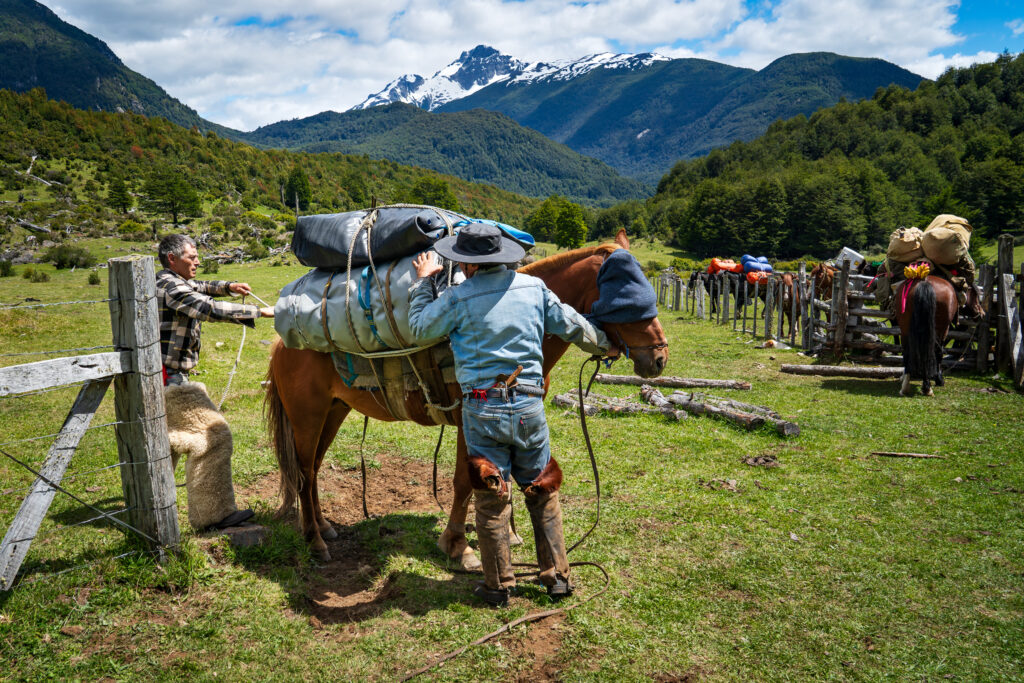
Gustavo and Rolando had asked us not to feed them. During the expedition, the skinniest one, the underdog of the pack, a black and tan Australian Shepherd-terrier mix (your guess is as good as mine), would subtly drift toward our group when we were eating. With the exception of a few weak moments, the gauchos’ wishes were respected.
The weather was beautiful during the seven-mile, relatively flat hike to the river. The horses effortlessly carried the gear. The horse with my son Cade’s safety kayak looked like a giant turtle waddling down the trail.
The path followed wild streams, passed beneath towering snow-capped mountains, and wound through an intact old-growth Coihue forest, broken only by a single remote homestead owned by an older gentleman who lived alone. Thrilled to have visitors, the butcher, known in the area not because he was a mass murderer, but because he traveled to Lago Verde once a week to run the town butcher shop, invited us into his two-room wooden house. He insisted we join him for mate, a bitter-tasting traditional caffeine drink popular with gauchos. A single cup with a metal straw is passed from one person to the next. To be polite, we left hygiene back in civilization and joined him. The cramped throng of us, combined with the blazing wood-fired cook stove, made the room unbearably hot. Nothing like starting a trip sweating, with the nearest shower a week away.
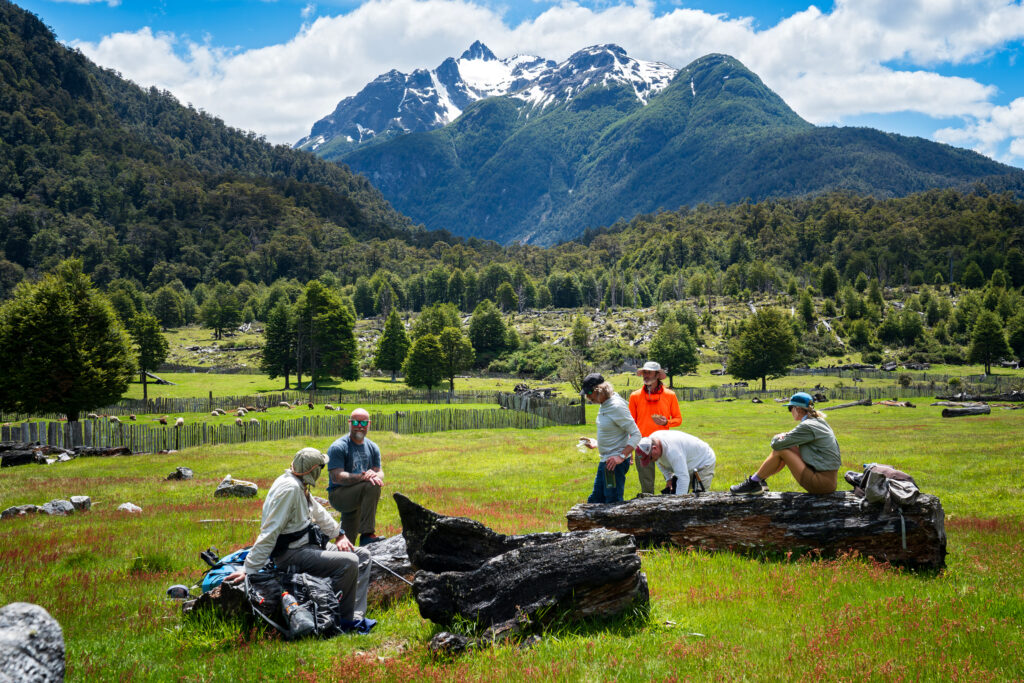 Low-hanging clouds obscured the views on our first day along the clear, gently flowing stream. We reached Gustavo’s farm just as it started to rain. We went to sleep camped on the banks of a gently flowing brook, and woke up to a swollen, brown river: not ideal for a first descent, and too high for the pack horses to cross.
Low-hanging clouds obscured the views on our first day along the clear, gently flowing stream. We reached Gustavo’s farm just as it started to rain. We went to sleep camped on the banks of a gently flowing brook, and woke up to a swollen, brown river: not ideal for a first descent, and too high for the pack horses to cross.
Pie in the sky
The day was spent huddled under a tarp strung from a beam in Gustavo’s half-finished barn, waiting for the water level to drop. In the early afternoon, the rain let up, but the valley was still socked in. Gustavo came over and asked if we’d like to see a window in the mountain.
A window? In a mountain? I recalled they mentioned a window when we first met in Lago Verde the year before. I turned to one of our Chilean river guides.
“Jamie, ask him, does he mean a mine shaft?”
“¿Quieres decir una mina?”
”No. Una ventana natural.” Gustavo insisted.
“He says there’s a natural window in the mountain and he can show us,” Jaimie said.
Perhaps some sort of natural bridge? The bedrock here was a hard granite, not a soft sandstone like you’d find in Arches National Park.
“¿Vamos?” Gustavo offered.
Traipsing around in the rain in search of Patagonia’s holy grail didn’t appeal to me, so I stayed behind to study the Google Earth screenshots and reflect on what the next few days might hold for us. The rest of the group, eight intrepid clients and six guides, including my two sons, Cade and Teal, went along to have a look. They came back soaked. If there was some sort of window, it was either lost in translation or hidden in the clouds.
By the following morning, the water had dropped to a level that the horses could cross. The valley was still shrouded in clouds, as it would remain for the next few days.
We were floating toward the first rapid when, suddenly, a series of tremendous splashes erupted from the right bank. In tight procession, the pack-laden horses, trailed by six dogs, leapt into the river a few hundred feet in front of us. The horses swam in a straight line, while the trailing dogs headed straight for us, battling the current at 45-degree upstream ferry angles, to avoid being swept down into the rapid. A collision with the dogs midstream would have sent them, and three rafts full of dog lovers, into the rapid together. I was about to call for a strong back paddle when the dogs reached the opposite shore and began shaking off. It was like a scene from a Disney movie, one that would be repeated numerous times throughout the week as the bridgeless trail wove its way down the remote valley.
The giant rapid that guarded the mysterious slot canyon below Gustavo’s farm, hidden in the shadow on Google Earth, came into view later that morning, and we pulled over to scout. Car-sized boulders choked the canyon entrance, with water flowing through, around, and under them. According to Google Earth, there was no elevation change within the canyon. If you could negotiate a way past the entrance rapid, which, with that day’s high water, led directly into sheer walls, the rest would be smooth sailing. At lower flows, the rafts might be lined with ropes around the entrance rapid. But that day, it was impassable.”Enigma Canyon,” as we named it, would remain just that.
We had arranged to meet Gustavo and Rolando above the canyon, where the trail left the river, in case it was necessary to portage the rafts and gear around. The horses turned out to be a blessing, as the hike around the canyon was long, steep, and muddy, and baggage boats would have cost us a miserable day.
Back in the boats, the swift, clear, teal-colored water raced over boulders, past schools of trout and the occasional salmon. With the valley still shrouded in clouds, the only thing missing was the Patagonian scenery Google Earth had promised.
The following day, we arrived at the giant cataract at their friend Waldo’s. We loaded the rafts onto the horses and hiked through open fields, past Waldo’s primitive barn and small wooden thatched-roof house. There was no sign of anyone.
“Where’s Waldo?” I asked. That was really his name… but I wasn’t sure if it was his first or last. Gustavo said he was probably out tending his sheep.
Falling Waters
Below Waldo’s Cataracts, we threaded the rafts through a challenging maze of smooth, sculpted white granite boulders for half a mile and rounded a bend where a trio of 400-foot ribbons of water plunged from a cliff beneath the clouds to the valley floor.
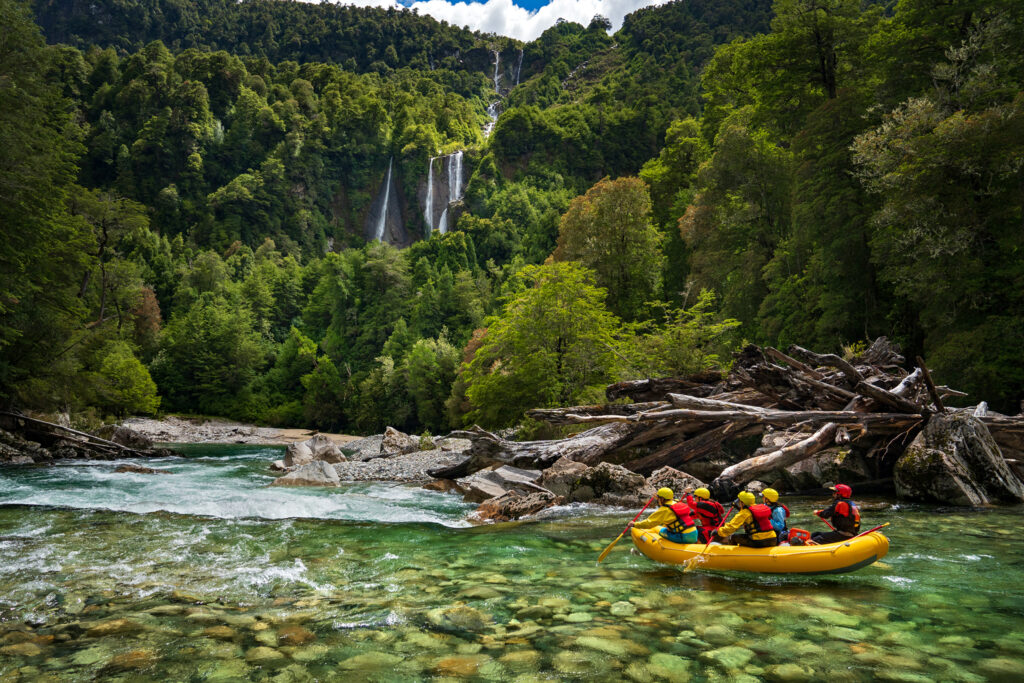
As stunning as the spectacle appeared from the river, the triple falls were even more impressive when we hiked up to them.
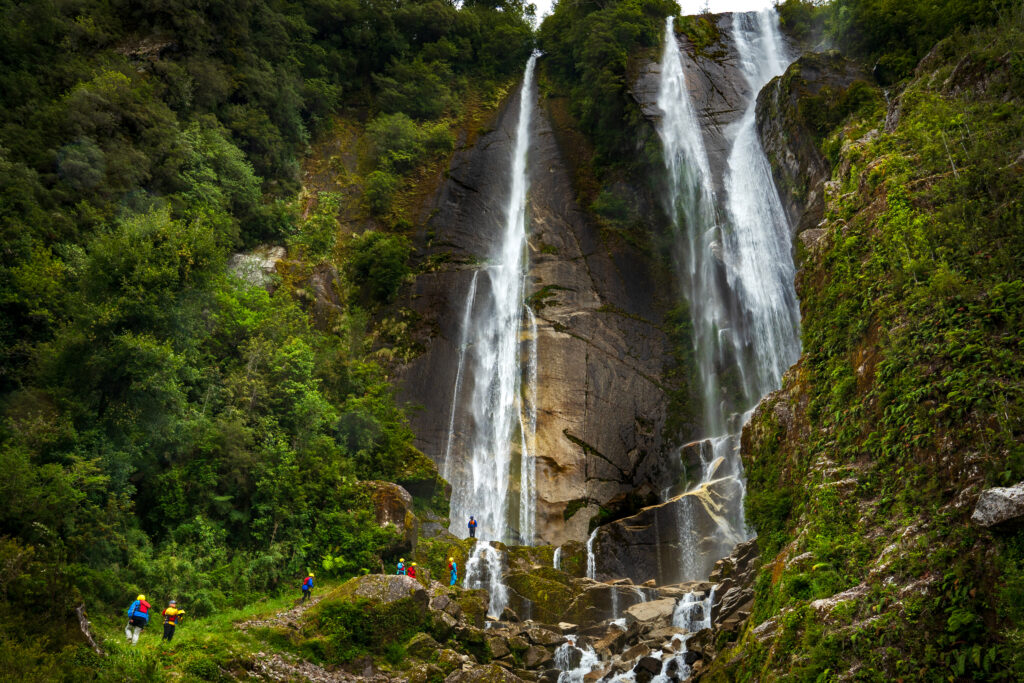
Below the falls, we ran the last of nearly two dozen rapids and pulled over at a beach where Gustavo and Rolando were waiting.
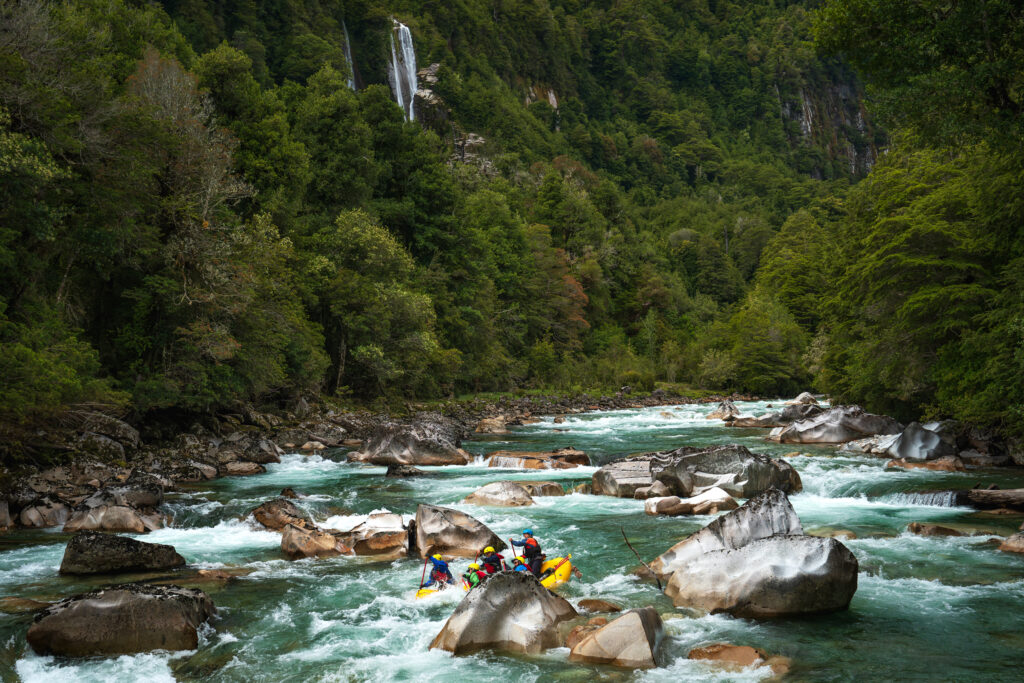
For the first time in days, the clouds began to clear. Ice-capped peaks and spires poked through, revealing glimpses of a fairytale-like landscape that had been hidden. Someone asked Gustavo and Rolando what was on the other side of the towering chain of peaks. They shrugged and responded that they didn’t know; no one had ever been there.
While we were rejoicing in the success of the expedition, I was already planning my return. With the exception of the cataract at Waldo’s and Enigma Canyon, both easily portaged with the horses, the river had the potential to be a classic.
Suddenly, out of nowhere, a small man with four dogs appeared and began exuberantly shaking everyone’s hand, some of us twice. Waldo barely cleared five feet. He was cloaked in natural-colored wool from head to toe and sported a black beret. His long, scraggly black beard clearly belonged to someone who didn’t own a razor. Above the beard, his face was dominated by a sustained, infectious smile and a pair of expressive, unruly eyebrows that stood up and out, rivaling those of Groucho Marx.
Unlike Gustavo and Rolando, who were reserved and had to be coaxed into joining the group photo, Waldo exuberantly plopped himself down in the middle of his 14 new, wetsuit-clad gringo buddies.
Gustavo explained that Waldo lived alone and that we were probably his first guests in six months. Waldo insisted that we join him back at his place for mate, but it was getting late.
As we were boarding the rafts, Waldo pulled Jamie aside and whispered something. Normally jovial, he seemed very serious, and I wondered if he was upset that we had turned down his mate invitation or tromped through his planted field.
“Waldo was wondering if his new good friends from America could bring him back something he can’t find in Chile,” Jaime announced to the group before we pushed the rafts off. “He’s a little shy about this,” Jaime added.
“Sure, what’s that?” I asked.
“A wife!” Waldo blurted out in impeccable English, smiling broadly, his eyebrows quivering. “Yes, please, thank you!” He called after us as we floated away.
We took out at the first bridge in a week. As we shook hands and said goodbye to Rolando and Gustavo, there was a sadness about them that contrasted with the exuberance of the rafters. Early in the trip, they had asked me about the possibility of doing future trips with them, and at the time, I honestly didn’t know. They had thoroughly enjoyed sharing their knowledge and river with people from half a world away who truly appreciated it. The seemingly insane plan, based on a few sheets of paper we had discussed in Lago Verde the year before, had opened their eyes to the possibilities. I got the feeling they believed this was a one-off trip and that we’d never return.
Truth and mythology collide
A month later, I was back on the Río Quinto with Jamie. We packed light and backpacked our gear in to avoid needing horses. This time, the weather cooperated.
On the water, the scenery was immense, and it was difficult to differentiate between the billowy cumulus clouds and the snow on the mountains. Everywhere, waterfalls that had been hidden during our first descent spilled from dizzying heights.
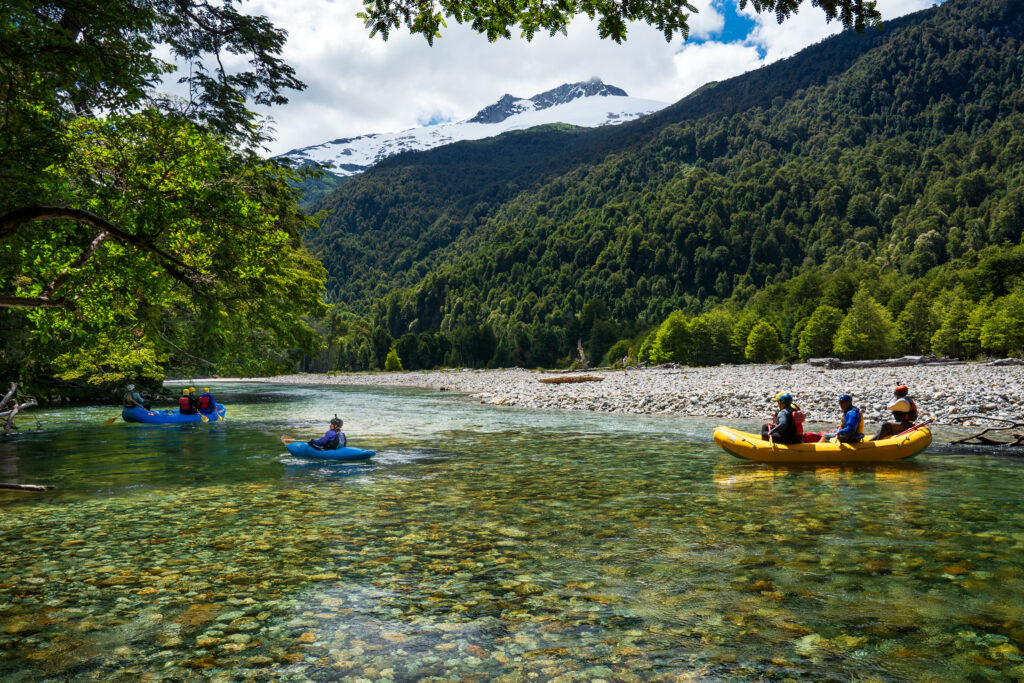
Halfway through our first morning, I glanced up through a break in the dense old-growth canopy and was intrigued by a flicker of sunlight filtering through a narrow slit high on a high ridge.
As we drifted downstream, our eyes fixed on the ridge, the gap grew wider and slowly opened before us. Could this be the mythical window Gustavo and Rolando had talked about? By the time we reached Gustavo’s farm, the 30-story-high, keyhole-shaped opening was large enough to fly a plane through. We pulled over and stood there, mesmerized, as billowy clouds alternated with bright blue sky in a giant kaleidoscope that was hard to wrap our minds around.
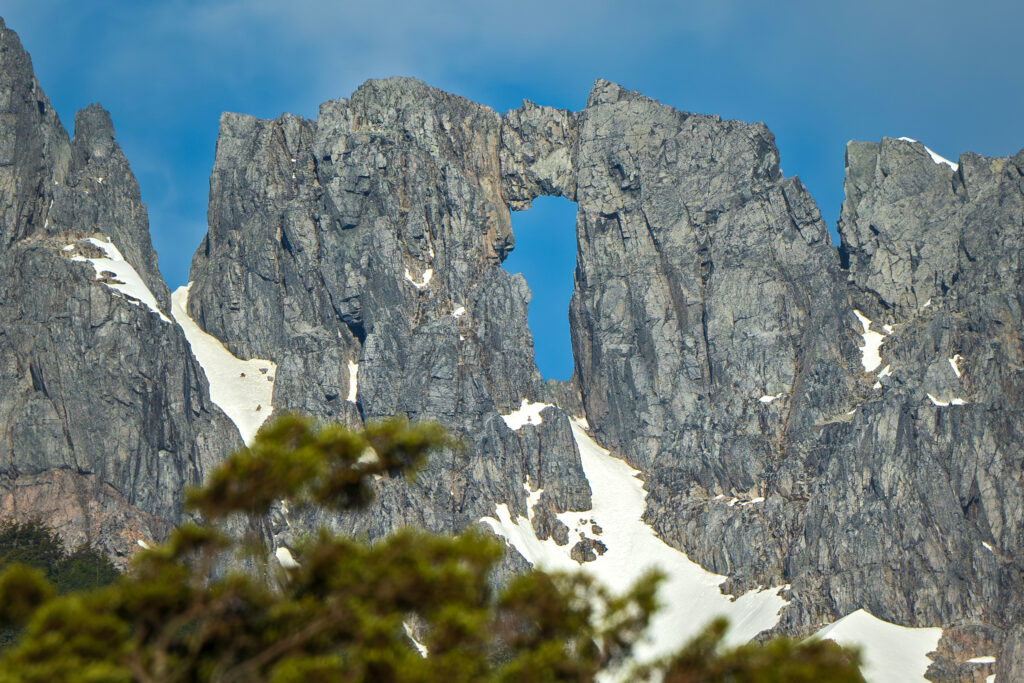
I later found out it was one of the largest mountain windows in the world. Its chief rivals, in Slovenia and China, are both major tourist attractions formed in porous limestone, which is highly susceptible to weathering and erosion. The Quinto Window, sculpted in hard, nearly impenetrable granite, was known only to a handful of gauchos, and now Jamie and me.
Enigma no more
The following day, we arrived at Enigma Canyon. The water level was lower than on the previous trip, and the entrance rapid was easily bypassed along the right shore.
We drifted through the entrance walls into one of the most beautiful places I had ever been. I pulled out of the current to slow my progress and take it all in. Trees, searching for light, leaned in over the moss-covered granite walls. Not a ripple disturbed the surface of the infinitely deep, clear teal water, where rainbow trout and salmon darted beneath us.
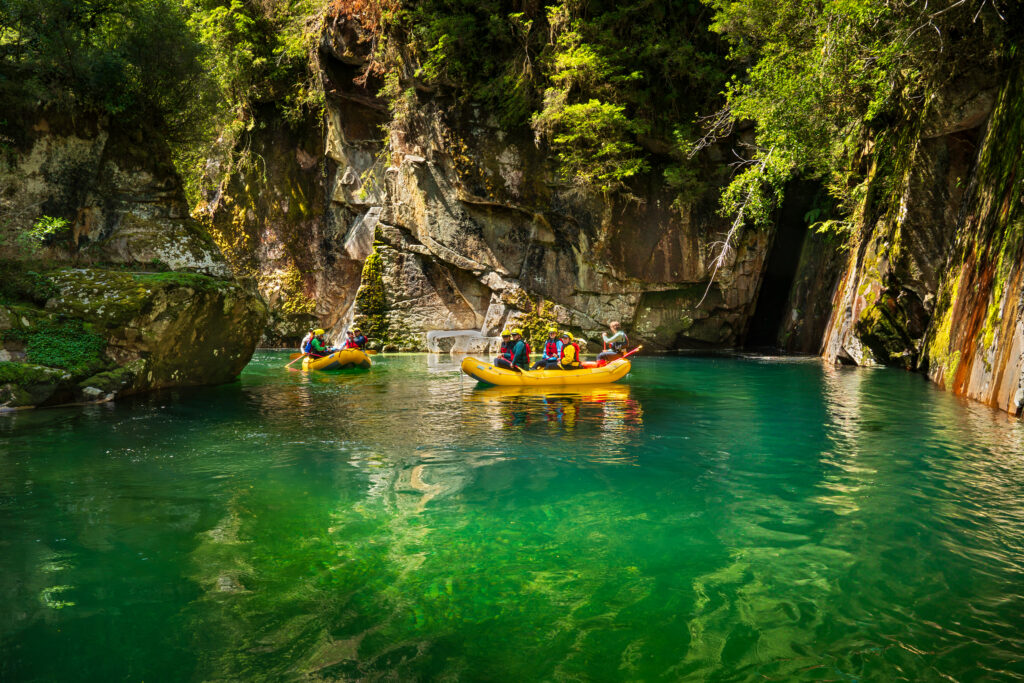
Patagonia Dolomites
As we exited the canyon, a snow-capped chain of Yosemite-like walls, spires, and ice-crowned peaks, rivaling the Italian Dolomites, rose from the river. The clear, teal water danced through one wonderful rapid after another, down to Waldo’s farm. Sharing a cup of mate with him would have to wait for a future trip, as he wasn’t home—probably just as well, since I hadn’t found him a wife.
While portaging the cataract, I glanced upstream, and there was the window, smaller but still visible, 25 kilometers later. In a geological miracle, the only ridge in the entire valley oriented at a 90-degree angle to the river contained the window, allowing it to be seen the entire length of the river.
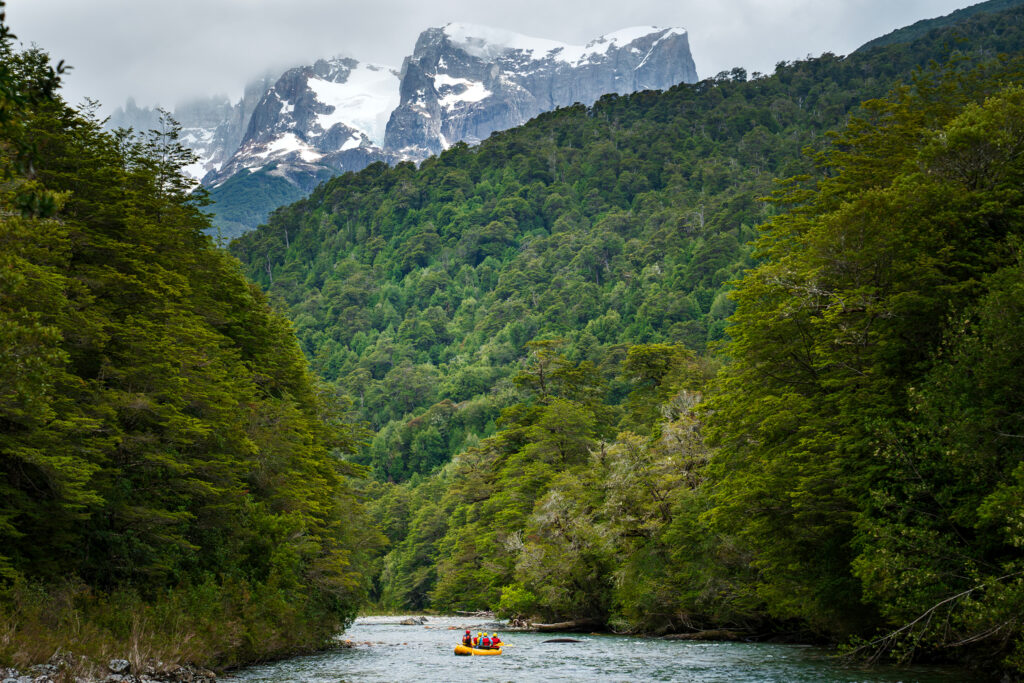
Renaming a Future Classic
On one of the early commercial trips, one of the guides, Ty, came up with the name “Río Ventana” for marketing purposes. “Window River” didn’t sound great in English, but in Spanish, it had a lyrical quality. Out of respect, I asked Gustavo and Rolando if they were O.K., with us calling it that. They liked the change and gave it their blessing. I didn’t get the chance to run it by Waldo, but he was more interested in finding a wife than what some Gringos called the river.
At the farewell dinner, one of the guests, Scott, who has done nearly every commercial river trip in the world, raised a toast: “To the Río Ventana, the most beautiful river I’ve ever been on.”
Earth River is currently offering trips on this spectacular unknown gem in December and early January. The journey is accompanied by Gustavo and Rolando, along with their horses and dogs. And you never know, you might even get the opportunity to share a cup of mate with Waldo.
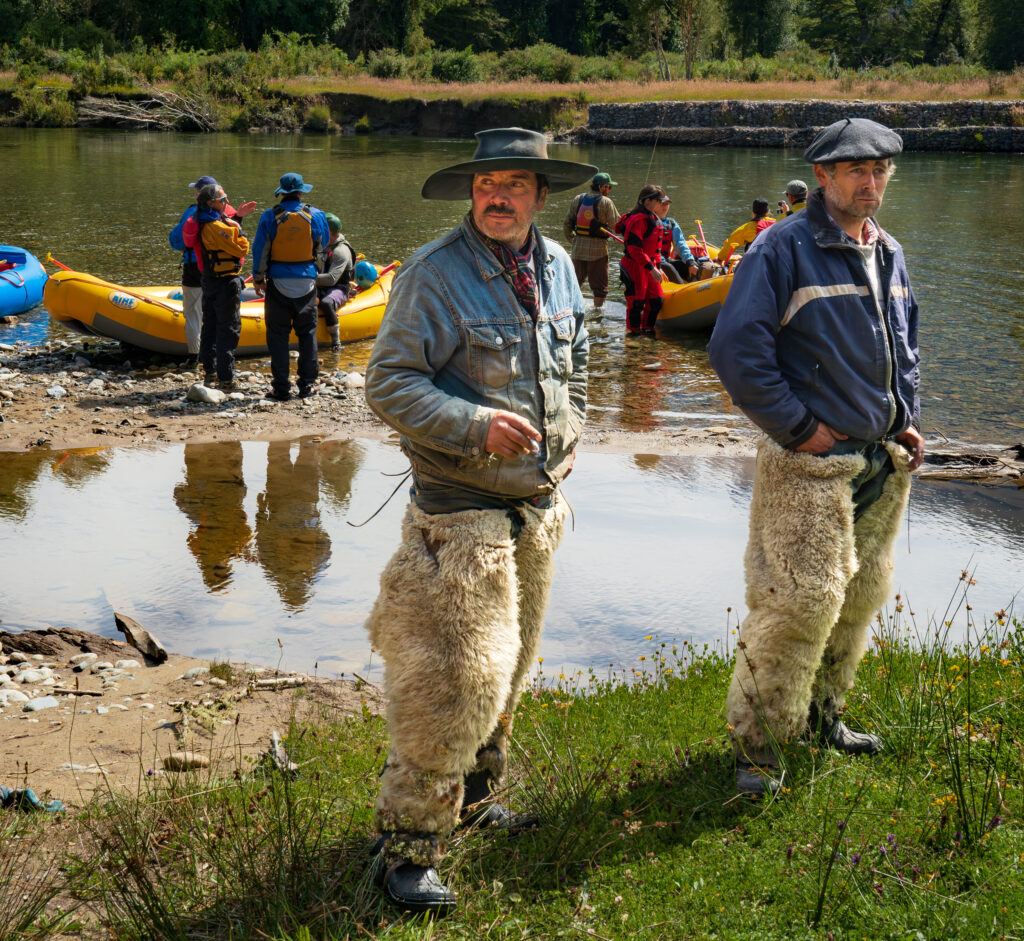
By Eric Hertz
